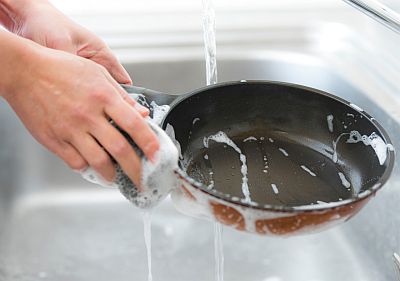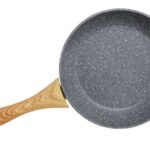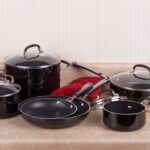Ceramic coatings are inorganic, non-metallic film layers that are applied to cookware to make it nonstick and scratch-resistant. Ceramic-coated cookware is a safer, non-stick alternative to traditional non-stick cookware. Many consumers prefer ceramic coatings over PTFE coatings for the following reasons:
- Ceramic-coated cookware is considered safe because it prevents chemicals from leaching into the food.
- Non-stick ceramic cookware helps prepare healthier meals because we can use less oil.
- It has higher heat and scratch resistance than PTFE-based coatings.
- Non-stick ceramic cookware is eye-catching and available in a variety of bright colors.
- Ceramic-coated cookware is easy to clean.
- It helps cook food evenly.
- This type of cookware is versatile.

How to Use Ceramic-Coated Pans
In most cases, you can use ceramic-coated pans on the stove, in the oven, in the steamer, in the toaster, or in the convection oven. Be sure to read the instructions and set the appropriate oven temperature.
You can also put it in the freezer and it is convenient for serving food.
Wash a ceramic pan before the first use
After removing all packaging materials and labels, wash the pan with warm, soapy water and wipe with a paper towel to remove dust particles and dirt from manufacturing and shipping. Rinse well. After this first wash, your pan is ready to use.
Use only non-metallic utensils when cooking in ceramic nonstick pans
Always use wooden, silicone, plastic, or nylon spoons and spatulas when serving food from ceramic-coated pans. Metal utensils have rough or sharp edges that can leave scratches and marks. Using safe utensils will help extend the life of your ceramic pans.

Add a small amount of oil or butter
Each time you cook in the pan, use a little oil or butter to coat the inside surface lightly and evenly. The light oil film prevents food from sticking and ensures the coating lasts longer. Avoid using cooking sprays as they can cause buildup. The cooking sprays may also contain ingredients that are too harsh for nonstick cookware. Additionally, avoid using virgin olive oil as it cannot withstand high heat and leaves a carbonized layer on the surface.
Use low to medium heat
Most ceramic-coated nonstick cookware cannot withstand high heat for long periods. Always use low or medium heat when cooking in nonstick ceramic pans or skillets. Preheat your pan on the lower setting and allow the oil to heat for a minute before adding the food to the pan. Ceramic distributes heat effectively so food cooks quickly and evenly. High heat can cause food to stick and discolor or damage the surface. Also, don’t let the pan cook dry.
Don’t immerse a hot pan in cold water
Allow nonstick ceramic cookware to cool completely before washing. Drastic temperature fluctuations can damage the non-stick coating, impairing its non-stick properties.
Don’t drop your ceramic pan
Do not drop a ceramic pan or hit it on hard objects. Also, be careful not to wrap or bend it, as such accidents can damage the ceramic coating and result in loss of non-stick properties.
How to Clean Ceramic Frying Pans
Read the manufacturer’s instructions
Read the manufacturer’s instructions for caring for your ceramic-coated cookware. Modern ceramic cookware is non-porous and has a very smooth surface which makes cleaning easier.
Always hand wash ceramic-coated pans
Always allow the pan to cool before cleaning. Clean your ceramic skillet with warm, soapy water and a soft sponge or dishcloth. To remove burnt food, soak the pan in hot water for 30 minutes before rinsing. This makes cleaning easier.
After each use, thoroughly clean the pan inside and out to remove any residue and prevent deposits and discoloration. For best results, use a soft cloth, sponge, or plastic cleaner to wash the pan. Avoid using steel wool, nylon scouring pads, or other abrasive cleaners. Rinse the pan well with warm water and dry it completely before storing it.
Deep Cleaning
Use this deep cleaning method regularly to remove stains and maintain the beautiful appearance of your ceramic-coated cookware.
Soak the pan in hot, soapy water and wash with a sponge or non-abrasive pad. Sprinkle a good amount of baking soda on desired areas and leave for 15-20 minutes. Then, using a plastic dish brush, lightly scrub the pan in a circular motion until the stains are removed. Rinse the pan under warm water and dry it with a clean towel.
Baking Soda is Awesome for Cleaning – Video
Seasoning
In general, ceramic cookware does not need to be seasoned. However, for some products, it is recommended to season the cookware before first use and to season it again approximately twice a year to revitalize the non-stick ceramic surface.
Be sure to rinse and dry your cookware before seasoning. Using a soft paper towel, lightly rub a tablespoon of vegetable cooking oil (good options include grapeseed oil, canola oil, and peanut oil) onto the cooking surface. If your cookware is oven-safe, you can heat it in the oven or on the stove. Heat the stove to medium-high heat or preheat the oven to 250 degrees Fahrenheit and heat the pan for about 3 minutes.
Remove the pan from the heat source and allow it to cool.
Wipe off any excess oil with a soft towel or cloth.
Repeat this revitalizing treatment at least every six months.
Proper Storage of Ceramic Pans
Always ensure your cookware is clean before storing it. Carefully store your ceramic skillets separately from other cookware, especially other ceramic pieces. Direct ceramic-to-ceramic contact can damage the surface. Other cookware stacked in the ceramic pan can also cause scratches on the surface.
When inserting non-stick ceramic pans, place a paper napkin between them to avoid scratches. There are also soft, spongy pot and pan protectors you can purchase to protect your nested pans from scratches.




Thanks for the information on how to take care of my ceramic coated cookware. I am definitely guilty of rinsing my hot pans under cold water to cool them down after use. I’ll be sure not to do this with my ceramic lined cookware to avoid damaging the nonstick coating! Great tip.
Number 5 is not true. Cleaning Advantium ceramic coated cookware is nearly impossible. GE’s official statement on cleaning is “use only warm sudsy water.” Total nonsense, as any person who has ever cleaned anything, can attest. I want to watch some GE executive clean one of their ceramic coated trays with “only warm sudsy water” after I cook a chicken, or a steak, or a hot dog, or a pizza, or pretty much anything on one.
you didn’t season them very well did you???
Why it leaves stain after using? Is it normal to ceramic coating to leave a residue or stain, and,what does it caused?
Leaving a ceramic pan empty on the burner or some foods like curry or tomato could result in staining the pan. You can easily remove those stains using baking soda as it is described in this article.
I have a ceramic pan that’s lost some of the non stick coating, is this still safe to cook with?
Ceramic pans may lose their non-stick property over time. This won’t affect the safety and they can be used as regular pans. However, if protective coating is cracked this may result in leaching of metals into food. You should consider replacing damaged ceramic pans, if you are concerned about food safety.
Thanks a lot for giving such a huge decription onthis topic.
helpful, but will avoid using “worm water” at all costs!
Fixed! Thank you.
Very helpful info. I am excited to use the first new cookware I ever had, and I’m 66 years old! Hope it’s as great as it sounds.
Any suggestion for veggie steamer? Have a metal one NOT conducive to ceramic cookware. Help?
Look near instant pot displays. Not sure if size would be compatible but they have silicon steamers for the instant pot that might work for you
It says to only use the pans on low-medium heat. What about boiling water? I typically use a high setting for that.
Boiling water can reach 212’F which won’t hurt your ceramic coated pan, even in a high-temperature setting. Make sure to put the pan on the stove with the water in, and don’t let it boil completely dry, which would expose your pan to higher heat.
Thank you! I Just bought stainless steel ceramic coated cookware. Your website was very informative.
So is there a way of cleaning that thin carbonized layer from these pans? I think I’ve now ruined my second pan because of this happening. I use only non-metal utensils, don’t fry on high heat, use a non-scratch pad for cleaning and have had chips, scratches, and nonstick properties gone. I will never buy this kind of pans again. Thanks.
I have a set of GreenPan ceramic cookware and they advise using a Mr. Clean Magic Eraser to remove that carbon build-up.
once it starts to stick and get a bit discolored is there a way to fix it?
I have the same problem
Still searching for a solution
I’m Mona, too! I use a greenpan! I find havn’t had that prob with this one! been v gd.
Do I need to season my ceramic coated Food Network 10 piece set?
What type of oil do you recommend using in these pans?
I would use a little vegetable oil or butter. Aerosol cooking sprays are not recommended, as these tend to build up on the cooking surface.
I lost my instructions on how to season or cure ceramic pans after many uses. Do you coat pan with thin layer of oil and put in oven at how many degrees and for how long? And how often?
I have just added a few paragraphs about seasoning to my post. I hope that would help.
I too just received Food Network Pans for Christmas and the directions were accidentally thrown away – Thanks for posting
Just came across this via Google. Thanks for the tips.
I have two large ceramic pans, one currently in use, and one in storage as a backup (I bought them on close-out). The one I’m currently using is discolored, and I’m looking for ways of cleaning it up and restoring the non-stick. Probably my own fault based on what I’m reading.
I tend to use higher than medium heat for frying potatoes. I’ll have to start cooking them slower. 🙂
You recommend vegetable oil, but I only use that when frying taco shells. Otherwise, I use olive oil. Will that make any difference?
EtG
Use baking soda paste + melamine sponge to occasionally restore
Avoid using virgin olive oil as it tends to burn on high heat and will create a carbonized layer on the ceramic pan.
It’s a bad idea to subject potatoes to high heat: above 120˚C/ 240˚F they produce acrylamide, a carcinogen. Since I learned that a few years ago, we have eaten our potatoes only boiled; no more roasted, fried, or baked potatoes, no more home fries, no more hash browns, no more pommes frites (sigh). Also, a few months ago I learned, after years of eating it five or six days a week, that all rice comes loaded with arsenic. Arsenic? Yikes. And there’s even more in brown rice. Also more in Texas and Louisiana rice and a little less in Indian and Pakistani rice. Is arsenic why I have peripheral neuropathy? Neurologist: dunno, maybe. So no more rice for us, no more risotto, and it’s noodles-only at Chinese, Indian and Vietnamese restaurants.
Thanks for so much helpful information.
I bought 2 german ones Zwilling and cannot use them. $ 175 down the drain. whatever I cook sticks. I use little oil = lots of oil, seasoned = whatever my eggs always stick. warm pans cold pans….. will not clean. cannot even fry hashbrowns. wont fry unless heat is up…. then it sticks and yes I use canola oils
I bought two ceramic Barbantia frying pans!! so non stick!! I hate them!! any solution please!!?
Thanks for this information. Happy cleaning ceramic cookware. We know something by reading this article. Carry on with kore information.
This is a great information, it helps me a lot! Thank you for your great work!!
This article is of great help. I bought two ceramic pans last month and I absolutely love them. This article will help me in making them last longer now. Thanks a lot
I love my set of two Green Pan skillets, 10-in & 12-in, that I purchased from Costco. They were fantastic for a while but then started sticking. I noticed a carbonized sticky layer forming and some staining. I went on Google and searched high and low for a solution to hopefully restore them. The baking soda paste worked fantastic and they are restored to new!! I’m not kidding! I just wet the pans, sprinkle some baking soda in them and mix into a paste. Then I use my non-scratch sponge and it works like magic! I can’t recommend it enough. I use it periodically when they start to feel sticky. TIP: “Never, never” use (so-called) “Non-stick Cooking Spray” on Ceramic OR Teflon non-stick pans. They have Lecithin in them which quickly builds up a “sticky coating” and defeats the non-stick surface. You can get some of it off of Ceramic w/baking soda but can’t use that on Teflon, just have to ditch them. Making up your own oil spray bottle is fine, just don’t use the store bought Non-Stick Cooking Sprays. Now go make those Ceramic pans like new again!!
Thanks for this very thorough and clear information!
Tyvm! This is the exact info i duckduckgo’ed.
I recently aquired an 8in after my cousin passed away n his children didnt want any of his belongings.
Im looking forward to using this pan with these awesome instructions!
Tthanks, I’m going to go try the baking soda method to clean mine right now! I have not been able to make an omelet in many months. My guess is it is not included in the instructions that come with the pans, because they don’t want to admit their wonderful “non-stick” pans don’t stay “non-stick”. (I’ll know soon enough.)